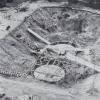NCBJ roots: History of Institute for Nuclear Research (1955-1982)
Institute of Nuclear Research (IBJ) was called in existence on June 4, 1955. It was possible thanks to that-time thaw in international relations. During almost 30 years Świerk physicists were learning how to build and operate reactors, accelerators, detectors, plasma devices... IBJ was split in 1982 into three smaller research institutions: Institute for Nuclear Studies (IPJ), Institute of Atomic Energy (IEA), and Institute of Nuclear Chemistry and Technology (IChTJ). It was a form of repression executed by martial law Poland authorities against rebellious Świerk researchers.
Nuclear physics attracted enormous interest in the first half of the 20th century. In the post-war Poland Professors Andrzej Sołtan in Warsaw as well as Henryk Niewodniczański and Marian Mięsowicz in Cracow were among the most eminent precursors in that field. Elementary Particle Physics Laboratory of the Polish Academy of Sciences was called into existence in 1954 in Warsaw. The first Polish particle accelerators and nuclear radiation detectors were developed in that Laboratory. The Laboratory worked out also a draft of a 5 MW research nuclear reactor. That time some results obtained in the field of nuclear physics were disclosed by the US, UK and USSR authorities, and nuclear technology was made available to other nations. In reaction to that Polish Government issued on June 4,1955 a decree to call Institute of Nuclear Research (IBJ) into existence. Professor Andrzej Sołtan was nominated IBJ first Director. Two years later Professor Soltan resigned and the post was assigned to Professor Jan Paweł Nowacki.
The Institute profile included research on atomic nuclei, nuclear engineering, practical applications of nuclear energy. USSR-designed EWA research reactor was built in Świerk, USSR-designed U-120 cyclotron was assembled in the Cracow branch of the Institute. Both these research facilities were put into operation in 1958. That year the Cracow branch of IBJ was transformed into an independent Institute for Nuclear Physics (IFJ). The MARYLA, ANNA and AGATA other zero-power reactors built in subsequent years in Świerk were used in nuclear physics research. In 1966 a decision to build another research reactor was made. The entirely Polish design MARIA reactor was put into operation in 1974 and is still in operation. Świerk research reactors have been used for many purposes, among others to manufacture radioisotopes for nuclear medicine, environment protection and industry. Radioactive waste was processed by Centre for Radioactive Waste Processing, next stored at a dedicated storage yard built in a post-military fort in Różan.
Accelerators of elementary particles developed in Świerk included the ANDRZEJ proton accelerator and various electron accelerators. The gained experience allowed to manufacture various machines for industrial radiographic examinations, for photo-activation-based chemical analysis of slurries in copper ore enrichment facilities, and for cancer radiotherapy (once very popular in Poland NEPTUN 10P machines). Demand for more and more complicated numerical computations in nuclear physics was initially satisfied by the GIER computer delivered by the A/S Regnecentralen Danish company and installed in Swierk in 1965. In 1974 a modern powerful CYBER machine supplied by Control Data Corporation was installed. Świerk researchers conducted some works to support the development of the Żarnowiec nuclear power plant in Poland, realized assignments to investigate characteristics of nuclear power reactors in Nowy Woroneż (USSR) and Kozłoduj (Bulgaria), and assisted some external suppliers nuclear power plant in Pacs (Hungary) to start up production of some equipment for the plant.
Research on nuclear fuel simultaneously conducted at the Żerań-located Institute branch was focussed on such topics as extracting pure metallic uranium from uranium ore and extracting trans-uranium elements from spent nuclear fuel. The LAE 13-9 linear accelerator of electrons was used among others to investigate influence of ionizing radiation on chemical processes and living organisms. The technology of manufacturing thermo-shrinkable plastic tubes and technology of sterilizing medical disposable supplies were developed.
Technologies and prototypes worked out in IBJ were next developed among others in the ZZUJ POLON company. Results of cooperation with the industry included computerized management systems (hardware and software) for brown-coal-fired power generating units. 12 such systems have been installed in the Bełchatów Power Plant..
IBJ research profile included high- and low-energy nuclear physics, nuclear chemistry, reactor physics and technology. The Institute cooperated with the most significant nuclear research centres in the world, including Dubna (USSR) and CERN (Geneva), as well as with numerous European institutions. A wide program of pure research was continued in IPJ and is still continued in NCBJ. Break-through results on hyper-fragments (new type of atomic nuclei, in which one of the nucleons is replaced by a strange particle, i.e. lambda hyperon) were probably the single most prestigious achievement. Discoverers of hyper-nuclei, Professors Marian Danysz and Jerzy Pniewski, were literally a hair's breadth of Nobel’s prize.
Institute of Nuclear Research was a stronghold of „Solidarity”. Political sympathies of majority of its employees and their reaction to introducing martial law in Poland in December 1981 provoked an angry reaction of that-time authorities. By means of a political decision IBJ was spilt in 1982 into three smaller research institutions. Almost 30 years later two of them (IEA and IPJ) were merged to form National Centre for Nuclear Research (NCBJ). Therefore three successors of original IBJ presently include:














